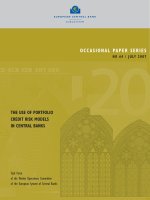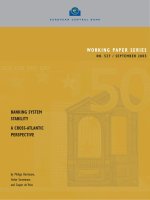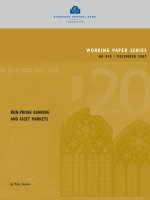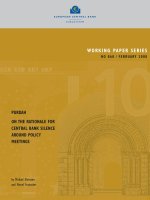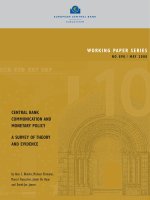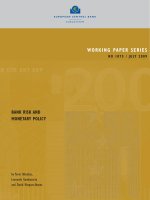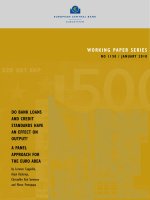Working PaPer SerieS no 967 / november 2008: Central bank miSPerCePtions and the role of money in interest rate rules pptx
Bạn đang xem bản rút gọn của tài liệu. Xem và tải ngay bản đầy đủ của tài liệu tại đây (1.05 MB, 53 trang )
Working PaPer SerieS
no 967 / november 2008
Central bank
miSPerCePtionS and
the
role of money
in intereSt rate ruleS
by Günter W. Beck
and Volker Wieland
WORKING PAPER SERIES
NO 967 / NOVEMBER 2008
In 2008 all ECB
publications
feature a motif
taken from the
10 banknote.
CENTRAL BANK MISPERCEPTIONS
AND THE ROLE OF MONEY IN
INTEREST RATE RULES
1
by Günter W. Beck
3
and Volker Wieland
2
This paper can be downloaded without charge from
or from the Social Science Research Network
electronic library at />1 Wieland thanks the European Central Bank that he visited as Wim Duisenberg Research Fellow and the Stanford Center for International
Development for the hospitality extended while part of this research was accomplished. Furthermore, we thank Athanasios Orphanides for
providing his data on historical U.S. output gap revisions and Christina Gerberding for the Bundesbank’s real-time data set with output gap
revisions. An earlier version of this paper was presented at the conference on “John Taylor’s Contributions to Monetary Theory and
Policy” at the Federal Reserve Bank of Dallas, October 2007. We have also benefited from seminar presentations at U.C. Santa Cruz,
U.C. Davis, FU Berlin, Birkbeck College, the European Central Bank, the Kiel Institute as well conferences at the Bundesbank, the
University of Cambridge and the Center for Financial Studies. We would also like to thank Ignazio Angeloni, Joshua Aizenman,
John Driffill, Tim Cogley, Alex Cukierman, Mark Gertler, Stefan Gerlach, Robert Hall, Otmar Issing, Robert Lucas,
Ronald McKinnon, John B. Taylor, Peter Tinsley, Carl Walsh, John C. Williams and Michael Woodford
for useful comments. All remaining errors are our own and the views expressed in this
paper do not necessarily reflect those of the European Central Bank.
2 Corresponding author. Contact: Professur für Geldtheorie und -politik, Johann-Wolfgang-Goethe Universität,
Mertonstrasse 17, D-60325 Frankfurt am Main, Germany, tel.: +49 69 798-25288, fax: +49 69 798-25272,
email: , , homepage: .
3 Goethe University Frankfurt, Mertonstrasse 17, D-60325 Frankfurt am Main, Germany;
e-mail: ;
© European Central Bank, 2008
Address
Kaiserstrasse 29
60311 Frankfurt am Main, Germany
Postal address
Postfach 16 03 19
60066 Frankfurt am Main, Germany
Telephone
+49 69 1344 0
Website
Fax
+49 69 1344 6000
All rights reserved.
Any reproduction, publication and
reprint in the form of a different
publication, whether printed or
produced electronically, in whole or in
part, is permitted only with the explicit
written authorisation of the ECB or the
author(s).
The views expressed in this paper do not
necessarily refl ect those of the European
Central Bank.
The statement of purpose for the ECB
Working Paper Series is available from
the ECB website, opa.
eu/pub/scientific/wps/date/html/index.
en.html
ISSN 1561-0810 (print)
ISSN 1725-2806 (online)
3
ECB
Working Paper Series No 967
November 2008
Abstract
4
Non-Technical Summary
5
1 Introduction
7
2 Output gap misperceptions and optimal policy
10
2.1 Optimal interest rate policy
under uncertainty
11
2.2 The irrelevance of monetary aggregates
15
2.3 Evaluating policy performance with
historical central bank misperceptions
16
3 Money and infl ation trends due to historical
output gap misperceptions
18
4 A general defi nition of cross-checking
22
5 Monetary cross-checking succeeds in stabilizing
infl ation trends due to historical output gap
misperceptions
25
6 Three questions concerning cross-checking
27
6.1 How would you account for velocity shifts
in monetary cross-checking?
27
6.2 Why does the cross-check take a
nonlinear form rather than a
linear feedback coeffi cient?
28
6.3 Why cross-check with money instead
of other variables?
30
7 Conclusions
31
References
34
Appendices
46
European Central Bank Working Paper Series
51
CONTENTS
Tables and fi gures
37
4
ECB
Working Paper Series No 967
November 2008
Abstract
Research with Keynesian-style models has emphasized the importance of the output gap
for policies aimed at controlling inflation while declaring monetary aggregates largely
irrelevant. Critics, however, have argued that these models need to be modified to
account for observed money growth and inflation trends, and that monetary trends may
serve as a useful cross-check for monetary policy. We identify an important source of
monetary trends in form of persistent central bank misperceptions regarding potential
output. Simulations with historical output gap estimates indicate that such misperceptions
may induce persistent errors in monetary policy and sustained trends in money growth
and inflation. If interest rate prescriptions derived from Keynesian-style models are
augmented with a cross-check against money-based estimates of trend inflation, inflation
control is improved substantially.
Keywords: Taylor rules, money, quantity theory, output gap uncertainty, monetary policy
under uncertainty.
JEL Classification: E32, E41, E43, E52, E58
5
ECB
Working Paper Series No 967
November 2008
Non-Technical Summary
Recent theoretical advances in New-Keynesian macroeconomics have de-emphasized the role
of money in the design of monetary policy. Optimal interest rate policy in New-Keynesian
models with price rigidities is conducted with reference to inflation forecasts and output gaps
but without direct concern for monetary aggregates. Some macroeconomists, however, have
expressed concern about the disappearance of money from monetary theory and policy. In
particular, Lucas (2007) criticized the New-Keynesian approach for neglecting money supply
measures in the estimation, testing or policy simulation of such macroeconomic models. He
argues that a role for money in the long run is sometimes verbally acknowledged, but that the
models themselves are formulated in terms of deviations from trends that are themselves
determined somewhere off stage. Lucas concludes that New-Keynesian models could be
reformulated to give a unified account of trends, including trends in monetary aggregates, and
deviations about trend but so far they have not been. In his judgement this question remains
an unresolved issue on the frontier of macroeconomic theory, and until it is resolved,
monetary information should continue to be used as a kind of add-on or cross-check.
In this paper, we address Lucas's request for a unified account of trends and deviations,
including monetary aggregates, and provide a formal analysis of his proposal to use monetary
information as a cross-check for policy. The central bank's beliefs regarding trends and
deviations play a central role in the analysis, specifically its estimates of the economy's
potential output and the implied output gap that drives inflation forecasts in Keynesian-style
models.
Research on optimal monetary policy design under uncertainty usually has to rely on a-priori
modeling assumptions regarding unobservable variables such as potential output. These
assumptions are needed to determine the optimal, model-based estimates of potential output,
on which policy is then conditioned. Orphanides (2003) has provided an alternative approach
for evaluating policies under uncertainty that avoids these particular a-priori assumptions by
using instead historical, real-time estimates of potential output. The true value of potential
output at any point in time is assumed to be equal to the central bank's final estimate on the
basis of information available many years later. We use historical series of central banks'
output gap estimates for the United States and Germany. Both series indicate very persistent
misperceptions regarding potential output.
Model simulations indicate that historical output gap misperceptions induce an inflationary
bias in interest rate policies that the central bank considered optimal conditional on its model
and associated forecasts. As a result, the central bank induces trends in money growth and
inflation even though it pursues a constant inflation target. Thus, as requested by Lucas,
Keynesian-style models built to explain inflation deviations from trend are able to provide an
account of money growth and inflation trends. This finding complements recent empirical
studies that have identified proportional movements in money growth and inflation at low
frequencies using a variety of filters and provides a structural explanation.
Next, a general definition of a policy with cross-checking that formalizes Lucas’s proposal is
presented. The cross-check incorporates expected trend inflation estimated from a simple
monetary model. The cross-check is triggered in a nonlinear-fashion whenever a statistical
test on the basis of the monetary model signals a trend shift. We show how to derive an
interest rate rule with cross-checking from an optimization problem and proceeds to
implement cross-checking in the benchmark New-Keynesian model
6
ECB
Working Paper Series No 967
November 2008
The policy with cross-checking against money-based estimates of trend inflation is found to
substantially improve inflation control in the event of persistent policy mistakes due to
historical output gap misperceptions. Furthermore, monetary cross-checking remains effective
in the event of sustained velocity shifts - the Achilles heel of traditional monetary targeting -
if standard recursive money demand estimation is applied. The nonlinear nature of interest-
rate adjustments due to cross-checking turns out to be essential. Linear policies with money-
based estimates of trend inflation perform substantially worse than cross-checking, whether
central bank estimates of the output gap are correct, on average, or not. Finally, cross-
checking can also be implemented successfully using inflation-based estimates of trend
inflation but money-based estimates would dominate if money leads inflation as indicated by
recent empirical studies.
7
ECB
Working Paper Series No 967
November 2008
1 Introduction
John Taylor’s research on monetary policy rules changed the economics profession’s focus from
monetary aggregates to the interest rate as the appropriate instrument for monetary policy.
1
Even the late Milton Friedman, in his last published writing, studied Taylor’s rule for interest
rate policy, though he tried to reclaim a role for money on its right-hand side.
2
Recent theo-
retical advances in New-Keynesian macroeconomics building on microeconomic foundations
with monopolistic competition and price rigidity have further de-emphasized the role of money
in monetary policy. As shown by Kerr and King (1996), Svensson (1997) and Clarida et al.
(1999) optimal interest rate policy in models with price rigidities is conducted with reference
to inflation forecasts and output gaps but without direct concern for monetary aggregates—
not unlike Taylor’s rule.
3
Some macroeconomists, however, have expressed concern about the
disappearance of money from monetary theory and policy. Lucas (2007), for example, writes:
“New-Keynesian models define monetary policy in terms of a choice of money mar-
ket rate and so make direct contact with central banking practice. Money supply
measures play no role in the estimation, testing or policy simulation of these mod-
els. A role for money in the long run is sometimes verbally acknowledged, but
the models themselves are formulated in terms of deviations from trends that are
themselves determined somewhere off stage.
1
Taylor (2006) writes on his progression from money to interest rates: “Taylor (1979) showed that a fixed
money growth rule - a Friedman rule - would have led to better performance than actual policy in the post World
War II period (but) a money growth rule which responded to economic developments could do even better. Since
then I have found that policy rules in terms of interest rates have worked better as practical guidelines for central
banks.”
2
Friedman (2006) notes at first that he always preferred a monetary aggregate for a policy instrument but then
takes the perspective of Taylor’s rule with the federal funds rate as instrument: “The Taylor rule is an attempt to
specify the federal funds rate that will come closest to achieving the theoretically appropriate rate of monetary
growth to achieve a constant price level or a constant rate of inflation. Suppose the federal funds target rate is equal
to a Taylor rule that gives 100 percent weight to inflation deviations. That may not be the right rate to achieve
the desired inflation target because other variables such as output or monetary growth are not at their equilibrium
levels. On this view, additional terms in the Taylor rule would reflect variables relevant to choosing the right target
funds rate to achieve the desired inflation target.”
3
The New-Keynesian model as laid out by Rotemberg and Woodford (1997) and Goodfriend and King (1997)
and developed in detail in Woodford (2003) and Walsh (2004) has quickly become the principal workhorse model
in monetary economics. The case against money is perhaps made most vigorously by Woodford (2006).
8
ECB
Working Paper Series No 967
November 2008
It seems likely that these models could be reformulated to give a unified account
of trends, including trends in monetary aggregates, and deviations about trend but
so far they have not been. This remains an unresolved issue on the frontier of
macroeconomic theory. Until it is resolved, monetary information should continue
to be used as a kind of add-on or
cross-check.”
We address Lucas’s request for a unified account of trends and deviations, including mone-
tary aggregates, and provide a formal analysis of his proposal to use monetary information as a
cross-check for policy. The central bank’s beliefs regarding trends and deviations play a central
role in the analysis, specifically its estimates of the economy’s potential output and the implied
output gap that drives inflation forecasts in Keynesian-style models.
Research on optimal monetary policy design under uncertainty usually has to rely on a-
priori modeling assumptions regarding unobservable variables such as potential output (cf.
Svensson and Woodford (2003) and Wieland (2006)). These assumptions are needed to de-
termine the optimal, model-based estimates of potential output, on which policy is then condi-
tioned. Orphanides (2003) has provided an alternative approach for evaluating policies under
uncertainty that avoids these particular a-priori assumptions by using instead historical, real-
time estimates of potential output. The true value of potential output at any point in time is
assumed to be equal to the central bank’s final estimate on the basis of information available
many years later. We use historical series of central banks’ output gap estimates for the United
States and Germany from Orphanides (2003) and Gerberding et al. (2005) respectively. Both
series indicate very persistent misperceptions regarding potential output.
Model simulations indicate that historical output gap misperceptions induce an inflation-
ary bias in interest rate policies that the central bank considered optimal conditional on its
model and associated forecasts. As a result, the central bank induces trends in money growth
and inflation even though it pursues a constant inflation target. Thus, as requested by Lucas,
Keynesian-style models built to explain inflation deviations from trend are able to provide an ac-
count of money growth and inflation trends. This finding complements recent empirical studies
that have identified proportional movements in money growth and inflation at low frequencies
9
ECB
Working Paper Series No 967
November 2008
using a variety of filters
4
and provides a structural explanation.
Next, a general definition of a policy with cross-checking that formalizes Lucas (2007)
proposal is presented. The cross-check is characterized by a first-order condition that in-
corporates expected trend inflation, which is estimated from a simple monetary model. The
cross-check is triggered in a nonlinear-fashion whenever a statistical test on the basis of the
monetary model signals a trend shift. An earlier note, Beck and Wieland (2007), presented
an interest rate rule that incorporates such a shift
5
and simulated a counterfactual example in
the traditional Keynesian-style model with backward-looking dynamics of Svensson (1997),
Orphanides and Wieland (2000) and Orphanides (2003). The present paper shows how to de-
rive an interest rate rule with cross-checking from an optimization problem and proceeds to
implement cross-checking in the benchmark New-Keynesian model.
6
The advantage of the Keynesian model with backward-looking dynamics is that it fits the
historical persistence in output and inflation and arguably embodies central bankers’ beliefs
on policy tradeoffs and monetary policy transmission in the 1970s and 1980s quite well. It
may be the better candidate for modeling central bank perceptions and describing historical
outcomes and was used for this purpose by Orphanides (2003). While the New-Keynesian
model is an unlikely description of central bank perceptions in the 1970s and 1980s, it has the
advantage of microeconomic foundations in optimal decision-making of households and firms.
Thus, it accounts for forward-looking, optimizing decision-making by market participants and
constitutes an important testing ground for policy strategies currently recommended to central
banks. For this reason, the subsequent analysis is carried out in both models in parallel.
The policy with cross-checking against money-based estimates of trend inflation is found
to substantially improve inflation control in the event of persistent policy mistakes due to his-
torical output gap misperceptions. Furthermore, monetary cross-checking remains effective in
4
See Gerlach (2004), Benati (2005), Pill and Rautananen (2006) and Assenmacher-Wesche and Gerlach
(2007).
5
Beck and Wieland (2007) point out that such an interest rate rule captures key elements of the ECB’s descrip-
tion of its two-pillar policy strategy. However, the ECB has never published a formal, mathematical exposition of
its strategy.
6
Our definition of monetary cross-checking is different from another interesting strategy proposed by
Christiano and Rostagno (2001) and Christiano et al. (2006) that combines monetary targeting with Taylor-style
interest rate rules.
10
ECB
Working Paper Series No 967
November 2008
the event of sustained velocity shifts—the Achilles heel of traditional monetary targeting—if
standard recursive money demand estimation is applied. The nonlinear nature of interest-rate
adjustments due to cross-checking turns out to be essential. Linear policies with money-based
estimates of trend inflation perform substantially worse than cross-checking, whether central
bank estimates of the output gap are correct, on average, or not. Finally, cross-checking can also
be implemented successfully using inflation-based estimates of trend inflation but money-based
estimates would dominate if money leads inflation as indicated by recent empirical studies.
The remainder of this paper is structured as follows. Section 2 presents the optimal interest
rate policy under uncertainty and explains how we introduce historical central bank misper-
ceptions into the analysis. Section 3 describes the relationship between trend money growth
and trend inflation and shows that central bank misperceptions represent an important source
of such trends in Keynesian-style models. Section 4 introduces the general definition of cross-
checking. Section 5 applies cross-checking in the event of central bank misperceptions. Section
6 subjects the policy with cross-checking to further sensitivity analysis and section 7 concludes.
An appendix provides further details on the models and their solution under cross-checking.
7
2 Output gap misperceptions and optimal policy
Keynesian-style models of inflation determination assign a central role to the output gap, that is
the difference between actual output and the economy’s potential. For example, the model used
by Svensson (1997), Orphanides and Wieland (2000) and Orphanides (2003) to study monetary
policy incorporates an accelerationist Phillips curve that relates current inflation, π
t
, to the gap
between current and potential output (in logs), y
t
− z
t
, lagged inflation, π
t−1
, and a cost-push
shock, u
t
:
π
t
= λ(y
t
− z
t
)+π
t−1
+ u
t
(1)
The slope parameter λ determines the trade-off between output and inflation.
Similarly, the New-Keynesian model of Rotemberg and Woodford (1997) and Goodfriend
7
Software for replicating the quantitative analysis in this paper is available from the authors upon request.
11
ECB
Working Paper Series No 967
November 2008
and King (1997) that was used by Clarida et al. (1999) to study the design of monetary policy
assigns center stage to the output gap in determining deviations from steady-state inflation,
¯
π,
next to expected future inflation, π
e
t+1
, and cost-push shocks:
π
t
− π = λ(y
t
− z
t
)+β(π
e
t+1
− π)+u
t
, whereπ
e
t+1
= E
t
[π
t+1
] (2)
Since this Phillips curve is derived from microeconomic foundations, the parameters have a
clear economic interpretation. β refers to the discount factor of optimizing households and
firms. λ is a function of the probability that firms are allowed to adjust prices according to
Calvo (1983). Furthermore, expectations regarding future inflation are formed in a rational,
forward-looking manner. Potential output, z
t
, which is an unobservable and model-dependent
variable, corresponds to the level of output that would be realized if prices were completely
flexible.
8
In the following, the Keynesian-style model associated with equation (1) is referred
to as the K-Model and the New-Keynesian model associated with (2) as the NK-Model.
2.1 Optimal interest rate policy under uncertainty
Optimal policy in the above-mentioned models prescribes that the central bank conditions its
policy decisions on its best estimate of potential output. This recommendation applies even
if the central bank’s objective focuses exclusively on stabilizing inflation without any explicit
concern for output fluctuations. The objective function of such a strictly inflation targeting
central bank is given by:
9
−
1
2
E
t
∞
∑
i=0
β
i
(π
t+i
− π
∗
)
2
. (3)
π
∗
denotes the central bank’s inflation target. In the following, it is normalized at zero along with
steady-state inflation,
π. The rational expectation E
t
[.] of the objective function is conditional
8
Traditional Keynesian models have typically related the measure of potential in the accelerationist Phillips
curve, equation (1), more loosely to the output implied by a standard model of long-run growth.
9
Our analysis can be extended to an objective function that includes output deviations from potential and
has welfare-theoretic foundations in the New-Keynesian model. Here, we focus on strict inflation targeting to
emphasize that our findings regarding the consequences of output gap misperceptions do not rely on including the
gap in the objective function. Thus, we are more likely to understate than overstate their negative implications.
12
ECB
Working Paper Series No 967
November 2008
on the particular model of inflation determination preferred by the central bank.
The optimal monetary policy that maximizes the above objective must satisfy the following
first-order condition:
10
E[π
t+i
|t, K/NK]=π
∗
= 0 ∀i = {0,1,2, ,∞}. (4)
The output level that would achieve this optimum at time t is given by
K-Model: y
t
= z
t
− λ
−1
(π
t−1
+ u
t
) (5)
NK-Model: y
t
= z
t
− λ
−1
u
t
(6)
Thus, the central bank aims for an output level above (or below) potential to the extent nec-
essary to offset inflationary pressures from cost-push shocks and—in the K-Model—inherited
inflation.
In practice, however, the central bank cannot observe potential output or particular shocks
with any certainty and needs to rely on estimates. We use the superscript
e
to refer to the
central bank’s estimates or perceptions of such unobservable variables. Thus, z
e
t|t
refers to the
central bank’s estimate of potential output in period t given the information available at that
point in time and u
e
t|t
to the cental bank’s estimate of the cost-push shock. We assume that
these perceptions represent the best available estimates of the unobservable variables from the
perspective of the central bank. Similarly, we use the superscript
e
as a short-hand for the
rational expectations of output and inflation. For example, π
e
t|t
= E[π
t
|t] represents the central
bank’s best forecast of inflation at the point in period t when it decides on its policy, i.e. before
it can observe the joint consequences of potential output, the cost-push shock and its policy
choice on inflation.
Fortunately, the optimal policy under uncertainty can be determined quite easily if the fol-
10
See Svensson (1997) for the K-Model and Clarida et al. (1999) for the NK-Model. In the NK model the
question arises whether to consider the optimal policy under discretion or commitment. Note, however, that for
strict inflation targeting the optimal policies under discretion and commitment are identical. If output were to be
included in the loss function we would analyze optimal policy under discretion.
13
ECB
Working Paper Series No 967
November 2008
lowing conditions are fulfilled: the model is linear, the parameters are known and uncertainty
is additive. In this case, certainty-equivalence applies, i.e. the optimal policy must satisfy the
first-order condition, equation (4), in expectation (see, for example, Svensson and Woodford
(2003) for the NK-Model and Wieland (2006) for the K-Model).
11
Then, the expected optimal
output level corresponds to:
K-Model: y
e
t|t
= z
e
t|t
− λ
−1
(π
t−1
+ u
e
t|t
) (7)
NK-Model: y
e
t|t
= z
e
t|t
− λ
−1
u
e
t|t
(8)
The conditions for certainty-equivalence—linearity, known parameters and additive uncertainty—
require making important a-priori assumptions regarding the processes that determine unob-
servable variables. Svensson and Woodford (2003), for example, assume that potential output,
z
t
, in the NK-model follows an auto-regressive process,
z
t
= νz
t−1
+ ε
z
t
, (9)
with known persistence parameter, ν, and known variance, σ
ε
z
.
12
Wieland (2006) makes a simi-
lar assumption regarding the natural rate in a version of the K-Model. Under these assumptions
the central bank can solve the estimation problem separately from the optimal policy problem.
Svensson and Woodford (2003) and Wieland (2006) show how to derive the optimal estimate
of potential output, z
e
t|t
,usingtheKalmanfilter. Conditional on this estimate the optimal policy
implies setting the nominal interest rate, i
t
, so as to achieve the expected output level defined
by equations (7) or (8), respectively. This value of the interest rate may be inferred from the IS
11
Certainty-equivalence fails if multiplicative parameters such as λ are unknown. Then, the central bank faces a
complex control and estimation problem. Examples are studied by Wieland (2000), Beck and Wieland (2002) and
Wieland (2006).
12
We are referring to equation (43) in Svensson and Woodford (2003). In addition, the authors assume the
central bank observes a signal regarding potential output that is correct up to an i.i.d. normal noise term.
14
ECB
Working Paper Series No 967
November 2008
equations:
K-Model: y
t
= y
t−1
− ϕ(i
t
− π
t−1
)+g
t
(10)
NK-Model: y
t
= y
e
t+1
− ϕ
i
t
− π
e
t+1
+ g
t
(11)
Thus, the optimal interest rate setting is given by:
K-Model: i
t
= π
t−1
+(ϕλ)
−1
(π
t−1
+ u
e
t|t
)+(ϕ)
−1
(y
t−1
− z
e
t|t
+ g
e
t|t
) (12)
NK-Model: i
t
=(ϕλ)
−1
(u
e
t|t
)+(ϕ)
−1
(z
e
t+1|t
− z
e
t|t
+ g
e
t|t
) (13)
This characterization of optimal interest rate policies can be simplified further by exploiting
modeling assumptions regarding the economic shocks. In particular, we assume that (g
t
,u
t
) are
i.i.d. normal with zero-mean and known variances (σ
g
,σ
u
). With regard to the K-Model we
follow common practice (cf. Svensson (1997), Orphanides and Wieland (2000)) and assume
that the central bank has no information on period t shocks when setting i
t
,i.e. g
e
t|t,K
= 0and
u
e
t|t,K
= 0. With regard to the NK-Model we follow Clarida et al. (1999) and assume that the
central bank has some information on current shocks. Specifically, we assume that the central
bank receives a signal (g
e
t
,u
e
t
) that is correct up to an additive noise term (ε
g
t
,ε
u
t
) with zero
mean. Thus, g
e
t|t,NK
= g
e
t
,andu
e
t|t,NK
= u
e
t
.
13
Consequently, the optimal interest rate policies correspond to:
K-Model: i
K
t
= π
t−1
+(ϕλ)
−1
(π
t−1
)+(ϕ)
−1
(y
t−1
− z
e
t|t
) (14)
NK-Model: i
NK
t
=(ϕλ)
−1
(u
e
t
)+(ϕ)
−1
(z
e
t+1|t
− z
e
t|t
+ g
e
t
) (15)
The optimal policy in the K-Model is a version of the famous Taylor rule, yet its coefficients
on inflation and the output gap need not coincide with the values of 0.5 that Taylor (1993)
used to match federal funds rate choices by the FOMC from 1988 to 1993. As to the optimal
13
More specifically, we assume that the true value of the demand and cost-push shocks, denoted by g
t
and u
t
respectively, are given by g
t
= g
e
t
+ ε
g
t
where ε
g
t
∼ i.i.d. N
0,σ
ε
g
and u
t
= u
e
t
+ ε
u
t
where ε
u
t
∼ i.i.d. N(0,σ
ε
u
).
Shocks to money demand are modeled in a similar fashion.
15
ECB
Working Paper Series No 967
November 2008
policy under the NK model, Clarida et al. (1999) already pointed out that it can be interpreted
as a forward-looking Taylor rule that responds to expected inflation and a measure of aggregate
demand disturbance.
It is important to note that we have followed Svensson and Woodford (2003) in adopting
the assumption of symmetric information in the NK-Model. Thus, the central bank, price-
setting firms and households share the same information regarding potential output and eco-
nomic shocks and form identical expectations regarding future output and inflation.
14
2.2 The irrelevance of monetary aggregates
So far, we have not discussed monetary aggregates because they are not needed to characterize
the transmission of interest rate changes to inflation in Keynesian-style models. In these models
changes in the nominal interest rate influence the real interest rate due to the presence of price
rigidities; the real interest rate determines the level of output; and the gap between actual and
potential output drives inflation. Of course, the models may be extended to include a standard
money demand equation
15
such as:
m
t
− p
t
= γ
y
y
t
− γ
i
i
t
+ s
t
. (16)
where γ
y
denotes the income elasticity of money demand, γ
i
the semi-interest rate elasticity and
s
t
an i.i.d. normal money demand shock. While the central bank controls interest rates via open-
market operations that also affect the money supply, the equilibrium level of money balances
is determined recursively from the money demand equation. For this reason, money does not
14
Svensson and Woodford (2004) also provide certainty-equivalence results under the assumption of asymmet-
ric information. In this case, which arises under a consistent application of the representative agent assumption,
households and firms know the true value of potential output. In our view, however, the assumption of symmetric
information is more appropriate for the policy problem at hand. In practice, individual private agents are unlikely
to know more about aggregate potential output than the central bank. If some individuals are particularly good at
estimating aggregate potential output, central banks will be eager to hire them or to buy their inflation forecasts.
One might even argue that it is more realistic to assume that the private sector is less knowledgeable about macroe-
conomic aggregates. Interestingly, however, the Bundesbank’s potential output estimates that we use later on were
made public in the 1970s and 1980s consistent with our assumption of symmetry (cf. Bundesbank (1973, 1981)).
15
This specification can be derived from the optimization problem of a household that values money holdings
according to a utility function that is separable in real balances and consumption goods (see Walsh (2003)).
16
ECB
Working Paper Series No 967
November 2008
appear in the optimal interest rate policies defined by equations (14) and (15). The quantity of
money adjusts so as to achieve the interest rate prescribed by the optimal policy. Technically,
m
t
is determined by equation (16) conditional on the desired interest rate and the current values
of real income and the price level.
What about the information value of monetary aggregates? Since we treat actual output and
inflation as observable variables, monetary aggregates have no additional information value.
The estimate of potential output, z
t|t
, discussed by Svensson and Woodford (2003) and Wieland
(2006) is obtained by means of the Kalman filter from past observations of output and inflation.
Monetary aggregates provide no relevant information as long as money balances do not appear
directly in the Phillips curve or the IS equation.
16
In practice, initial values of GDP, the GDP
deflator and monetary aggregates are revised for a few quarters. While GDP is only available
on a quarterly basis, monetary aggregates are available on a monthly frequency and tend to
be revised less. Thus, monetary aggregates may provide information that helps improve initial
estimates of actual output. This information role of monetary aggregates is investigated by
Coenen et al. (2005). They show that initial GDP estimates for the euro area are revised more
substantially than monetary aggregates. Using an estimated model of the euro area with rational
expectations they find that optimal estimates of current GDP assign some weight to monetary
aggregates, but this weight is very small.
17
2.3 Evaluating policy performance with historical central bank misper-
ceptions
We have already pointed out that the optimal policy depends importantly on the central bank’s
estimate of potential output, z
t|t
. A possible route for further analysis would be to follow
Svensson and Woodford (2003) and Wieland (2006) in studying policy performance using cal-
16
Ireland (2004) and Andres et al. (2006) investigate the direct role of money balances in output and inflation
determination. They suggest that such direct effects are of minor importance.
17
Coenen et al. (2005) assume that the central bank and the private sector have symmetric information and apply
the same filtering techniques as in Svensson and Woodford (2003). An interesting paper by Dotsey and Hornstein
(2003) investigates this question in a calibrated model of the U.S. economy under the assumption of asymmetric
information as in Svensson and Woodford (2004). Their findings regarding the information value of money are
even more negative.
17
ECB
Working Paper Series No 967
November 2008
culations that make use of a-priori assumptions concerning the unobservable process determin-
ing potential output, i.e. equation (9). Instead, we choose a different research strategy following
the influential study of Orphanides (2003). Orphanides used historical output gap estimates to
argue that the Taylor rule would not have been able to prevent the “Great Inflation” of the 1970s.
Orphanides (2003) collected real-time data on U.S. inflation and output including real-time
estimates of potential output obtained by the Council of Economic Advisers (1966-1980) and
the Federal Reserve (1980-1994).
18
On this basis, we denote the difference between the real-
time estimate of potential output and the final estimate as of 1994 as e
t
:
e
t
= z
e
t|t
− z
e
t|1994
(17)
e
t
provides a lower-bound on the extent of the central bank’s misperception of potential output
since estimates may still have been revised after 1994. Thus, Orphanides (2003) proposed to
analyze policy treating the final estimate in 1994, z
e
t|1994
, as the true value of potential output,
z
t
:
z
e
t|t
= z
t
+ e
t
(18)
The resulting series of real-time U.S. output gap misperceptions, E
t
[y
t
−z
t
]−(y
t
−z
t
),isshown
by the solid line in Figure 1.
Critics have argued that the potential GDP measures constructed by the CEA were politi-
cized maximum measures not taken seriously by Federal Reserve decision makers. Therefore,
we contrast the U.S. CEA-FRB output gap misperceptions provided by Orphanides (2003) with
a similar series from Gerberding et al. (2005) for Germany from 1974 to 1999. This series is
shown by the dashed line in Figure 1. In this case, the underlying production potentials are the
Bundesbank staff’s estimates.
19
The Bundesbank started to produce its own estimates of poten-
18
The output gap data for the 1980s and 1990s of Orphanides (2003) was constructed from the Greenbook, the
Federal Reserve document summarizing the Board staff’s analysis of economic developments distributed to the
FOMC members a few days before each FOMC meeting. For the 1960s and 1970s Orphanides could not recover
a complete time series for potential output estimates from Federal Reserve sources but notes that discussion of
output gap measures appeared in the FOMC Memorandum of Discussion throughout this period. Thus, he uses
real-time estimates of potential output that were produced by the Council of Economic Advisers (CEA) in those
years and available at FOMC meetings.
19
The data were reconstructed from official Bundesbank publications and from internal documents such as the
18
ECB
Working Paper Series No 967
November 2008
tial output in the early 1970s. Its methods are described in detail in Bundesbank (1973). The
Bundesbank made clear that it aimed to construct a measure consistent with price stability—not
a maximum measure.
Both series of historical output gap revisions indicate very persistent misperceptions by the
respective central bank. This persistence arises primarily from the estimates of unobservable
potential output, since revisions to actual output decline much more rapidly than those to the
output gap. Both series indicate that the production potential of these economies was over-
estimated through the 1970s and well into the 1980s. U.S. and German policy makers taking
into account these estimates were led to believe that their respective economies suffered a very
deep recession from 1974 to 1976. In retrospect, however, this period appears as a mild reces-
sion in the United States and as a decline from excessive levels towards potential in Germany.
To the extent the Federal Reserve or the Bundesbank based their inflation forecasts on the
output gap estimates available at the time, they must have concluded that inflation would soon
decline. In retrospect, such a forecast would have been wrong. Using an estimated variant of
the K-Model for the United States Orphanides (2003) showed that if interest rates had been
set according to Taylor’s rule with historical output gap estimates, inflation would have risen
dramatically. Thus, he concluded that Taylor’s rule would not have helped the FOMC avoid the
“Great Inflation” of the 1970s, as long as it believed the output gap estimates.
3 Money and inflation trends due to historical output gap
misperceptions
In the following, Orphanides (2003)’ findings regarding the effect of historical central bank
misperceptions on inflation under Taylor’s rule are shown to extend to the optimal interest rate
policies in the K- and NK-Model. Furthermore, it is shown that central bank misperceptions
constitute an important source of common trends in money growth and inflation similar to
the low-frequency co-movements identified by recent empirical studies. Thus, Keynesian-style
models with central bank misperceptions can provide a unified account of short-run deviations
briefing material for the Council’s discussions on the monetary target for the year to come.
19
ECB
Working Paper Series No 967
November 2008
from trend as well as long-run movements in money growth and inflation as requested by Lucas
(2007).
In a first step, the long-run equilibrium values of money growth and inflation are derived.
To this end, the money demand equation (16) is re-arranged and first-differences are taken to
obtain a short-run relationship between money growth and inflation:
π
t
= Δp
t
= Δm
t
− γ
y
Δy
t
+ γ
i
Δi
t
− Δs
t
. (19)
Here, Δ denotes the first-difference operator. In the long run, money demand shocks will av-
erage to zero; the nominal interest rate will converge to its constant steady-state level and its
first-difference to zero;
20
and output growth will converge to the steady-state growth rate of
potential, Δ ¯y = Δ¯z. Thus, long-run inflation is proportional to long-run money growth adjusted
for trend output growth and trend velocity
21
:
π = Δ ¯m − γ
y
Δ ¯y = ¯μ. (20)
Recent empirical studies confirm the long-run proportional relationship between inflation and
money growth (cf. Gerlach (2004), Benati (2005), Pill and Rautanen (2006) and Assenmacher-
Wesche and Gerlach (2007). These studies use various types of filters. Gerlach (2004), for
example, defines filtered money growth as
Δm
f
t
= Δm
f
t−1
+ ω
Δm
t
− Δm
f
t−1
. (21)
Accordingly, we obtain a filtered measure of adjusted money growth from equation (20):
μ
f
t
= Δm
f
t
− γ
y
Δy
f
t
. (22)
20
The steady state level of the nominal interest rate corresponds to the sum of the equilibrium real interest rate
and the inflation target.
21
Specifically, with velocity defined as v
t
≡−m
t
+ p
t
+ y
t
and money demand determined by equation (16) the
long-run trend in velocity corresponds to Δ ¯v =(1 − γ
y
)Δ ¯y.
20
ECB
Working Paper Series No 967
November 2008
Interestingly, the empirical studies cited above report that filtered measures of money growth
tend to lead filtered inflation by several quarters. This property would render μ
f
t
a particularly
useful forecast of impending movements in trend inflation. However, the timing assumptions of
the Keynesian-style models with money demand presented in section 2, preclude such a leading
indicator role of filtered money growth. This question is discussed further in section 6.
The next step is to introduce central bank misperceptions. Thus, the perceived potential out-
put, z
e
t|t
, in the optimal interest rate policies (equations (14) and (15)) is replaced with the histor-
ical, real-time estimates for the U.S.A. and Germany, respectively. Similarly, the true value, z
t
,
in the Phillips curves (equations (1) and (2)) is replaced with the final estimates (U.S.A.: 1994,
Germany: 1999). The difference between real-time and final estimates constitutes the output
gap misperception, e
t
. Then, the models are simulated by drawing from the shock distributions
and parameter values posited in Table 1. Thus, a-priori assumptions regarding the true structural
process driving unobservable potential (cf. equation (9)) are avoided and policy performance is
evaluated with data on historical misperceptions. It is straightforward to show that inflation will
inherit the persistence properties of historical output gap misperceptions:
K-Model: π
t
= λe
t
+ λg
t
+ u
t
(23)
NK-Model: π
t
= λe
t
+ λε
g
t
+ ε
u
t
(24)
Thus, actual inflation will persistently deviate from the zero inflation target even though the
central bank aims to offset all forecasted deviations conditional on its preferred Keynesian-style
model and associated gap estimate.
Figure 2 reports simulations with U.S. and German output gap misperceptions in the K-
model for a given draw of exogenous shocks and noise terms.
22
The first row of two panels
shows the rate of inflation, π
t
,andthefiltered measure of adjusted money growth, μ
f
t
, with U.S.
output gap misperceptions. From period 15 onwards till period 135 the difference between the
true and the perceived output gap corresponds to the difference between real-time and 1994
22
The sequence of shocks is arbitrary but we obtain similar results for many alternative draws and will discuss
averages later on in this section.
21
ECB
Working Paper Series No 967
November 2008
estimates from Orphanides (2003). The persistent over-estimate of potential output induces the
central bank to set interest rates too low to maintain price stability. Thus, money growth and
inflation increase and inherit the serial correlation of the central bank’s misperceptions regarding
potential output. Over time, also the filtered measure of adjusted money growth, μ
f
t
, increases as
shown in the second panel of the first row. The lower two panels of Figure 2 report a simulation
with the Bundesbank misperceptions from Gerberding et al (2005). Again, the misperceptions
start in period 15. From then on, policy is too accommodative and (adjusted) money growth and
inflation increase up to a peak of around 5 percent in spite of the central bank’s constant target
of zero inflation. This peak is somewhat smaller than in the case of the U.S. misperceptions
thattriggeranincreaseuptoaninflation rate of 6 percent. In both cases, filtered money growth
provides a good mirror image of the trend movement in inflation.
Why does the central bank accept this sustained increase in inflation? The reason is that
it conducts a policy that is believed to be very effective in stabilizing inflation. Its forecast of
inflation that is based on its preferred estimate of the output gap indicates a recession. Con-
sequently, the central bank continuously predicts an imminent decline in the rate of inflation.
If it were to raise interest rates further its forecast would signal a worsening of the recession
and an undershooting of its inflation target. Ex-post, the estimation procedure that is employed
by the central bank to obtain its potential estimate, z
e
t|t
, attributes the persistent forecast misses
to a sequence of unfavorable shocks. Such a reconciliation of potential output estimates and
observed inflation performance is not without historical parallel. Many accounts of the 1970s
attribute the stagflation in the United States and Germany primarily to inflationary and reces-
sionary consequences of oil price shocks.
23
We obtain similar results with the New-Keynesian model (not shown). Rather than report-
ing more individual simulations, we turn to a summary overview in Figure 3 on the basis of
averages over 1000 simulations with U.S. and German output gap misperceptions in the K- and
NK-Model, respectively. For each of the four possible combinations, we show two panels that
23
Orphanides (2003) describes how potential output estimates for the U.S.A. were eventually revised downwards
following the sustained increase of inflation. Similarly, the Bundesbank learned from its mistakes. However, these
revisions occurred in several steps and after a substantial period of time.
22
ECB
Working Paper Series No 967
November 2008
report the cross-simulation averages of inflation, π
t
,andthefiltered measure of adjusted money
growth, μ
f
t
. A comparison of these panels indicates that filtered money growth matches low-
frequency movements in inflation very well. Thus, the monetary model derived from the quan-
tity theory explains trend inflation very well. Money and inflation trends are due to the same
source, namely persistent central bank misperceptions with regard to potential output. These
misperceptions provide a structural explanation of the trends identified in recent empirical stud-
ies by Gerlach (2004), Benati (2005), Pill and Rautanen (2006) and Assenmacher-Wesche and
Gerlach (2007). In other words, the introduction of imperfect knowledge and persistent cen-
tral bank misperceptions in Keynesian-style models is sufficient to provide a unified account
of trends and deviations, including monetary trends—the unresolved issue on the frontier of
macroeconomic theory emphasized by Lucas (2007). An alternative explanation of common
trends in money growth and inflation would be an on-going shift in the central bank’s infla-
tion target, i.e. upwards in the 1970s and downwards in the 1980s. However, there exists no
direct evidence of such a change in central bank objectives. Our explanation with a constant
inflation target but persistent policy mistakes offers an alternative that is grounded in empirical
observation in terms of historical output gap revisions.
4 A general definition of cross-checking
In light of the empirical evidence on concurring trends in money growth and inflation, Lucas
(2007) proposed to use monetary information as an add-on or cross-check in interest rate policy.
In this section, we provide a formal interpretation of his proposal. We start by reiterating the
first-order condition that describes the optimal policy derived under certainty-equivalence:
E[π
t+i
− π
∗
|t]=0 ∀i = {0,1, 2, , ∞} (25)
It implies that trend inflation equals the inflation target in expectation. Specifically, E[π
t+N
|t] →
E[
π] as N → ∞, and consequently:
E[
π]=π
∗
(26)
23
ECB
Working Paper Series No 967
November 2008
Thus, a policy maker who trusts that the Keynesian-style model correctly describes the
economy, expects that trend inflation will turn out to match the target as long as policy is set to
stabilize expected inflation in every period.
24
However, such confidence in model-based forecasts and estimates of unobservable variables
may be misplaced. The simulations of historical output gap misperceptions conducted in the
preceding section provide an example that sustained trend deviations from target may occur
even under policies that aim to stabilize inflation as close to target as seems feasible on the
basis of model forecasts. Following Lucas’s recommendation, a sceptical policy maker may
instead prefer a simpler model of trend inflation based on monetary information. In fact, the
preceding section offers a simple candidate model derived from the quantity equation:
E[
π]=E[μ
f
] (27)
This relationship holds in the Keynesian-style models of section 2, but would also remain valid
if the true structure of the economy were to correspond to a real business cycle model without
any price rigidities. Thus, a policy maker in the monetarist tradition, who distrusts short-run
inflation forecasts, may instead focus on controlling trend inflation. Such a monetarist policy
maker would conduct open-market operations in period t so that trend inflation as estimated by
the most recent observation on filtered adjusted money growth is expected to equal the inflation
target:
E[
π|μ
f
t
]=π
∗
= 0 (28)
Since μ
f
t
is constructed from money growth and actual output growth observations, it may be
monitored without relying on model-based estimates of potential output. As a result, the mon-
etary strategy can succeed in stabilizing trend inflation in spite of output gap misperceptions.
25
Clearly, such a monetarist approach may appeal to a central banker who gives priority to
managing first-order risks. In our view, however, it goes too far in abandoning any attempt at
24
Similarly, a flexibly inflation targeting central bank that aims to stabilize inflation and output gap would expect
that trend inflation equals the target since the trend output gap equals zero in expectation.
25
Of course, a natural question concerns the implications of sustained velocity shifts for this strategy of stabiliz-
ing trend inflation. We return to this question in section 6.
24
ECB
Working Paper Series No 967
November 2008
short-run inflation stabilization. After all, Keynesian-style models may not be that far off the
mark and potential output estimates need not always be utterly wrong. Instead, we follow Lucas
(2007) and investigate how to use monetary information as a cross-check rather than as a policy
prescription that is applied in every period.
We formalize the idea of cross-checking in the following manner. In every period, the
central bank checks whether filtered money growth is still consistent with attaining the inflation
target, or whether money growth trends have shifted, by monitoring the test statistic,
κ
t
=
μ
f
t
− π
∗
σ
μ
f
, (29)
and comparing it to a critical value κ
crit
. Here, σ
μ
f
denotes the standard deviation of the filtered
money growth measure. It can be determined under the null hypothesis that the central bank’s
preferred Keynesian-style model is correct.
As long as the test statistic does not signal a sustained shift in filtered money growth, the
central bank implements the optimal policy under the preferred Keynesian-style model, i.e. the
policy that satisfies the first-order condition (4). Thus, in the absence of persistent output gap
misperceptions it can stabilize short-run inflation variations very effectively.
Once the central bank receives successive signals of a shift in trend inflation as estimated by
filtered money growth, i.e. (κ
t
> κ
crit
for N periods) or (κ
t
< −κ
crit
for N periods), policy is
adjusted so as to control trend inflation.
26
The policy with cross-checking may be characterized
with a first-order condition that includes trend inflation:
E[π
t
|z
e
t|t
,K/NK]=−E[π|μ
f
k
] (30)
This condition guarantees that the central bank acts to offset any significant shift in trend in-
flation as estimated on the basis of monetary information. μ
f
k
denotes the most recent significant
26
The two parameters κ
crit
and N play different roles. κ
crit
reflects the probability that an observed deviation of
μ
f
from π
is purely accidental (for example a 5% or 1% significance level). N defines the number of successive
deviations in excess of this critical value. Thus, the greater N the longer the central bank waits to accumulate
evidence of a sustained policy bias.
